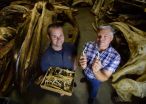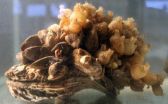(Press-News.org) Dr. John Carr, a scientist at the U.S. Naval Research Laboratory, is part of an international team that has discovered what they believe is evidence of a planet forming around a star about 335 light years from Earth. This research is published in the August 20th issue of The Astrophysical Journal.
Carr and the other research team members set out to study the protoplanetary disk around a star known as HD 100546, and as sometimes happens in scientific inquiry, it was by "chance" that they stumbled upon the formation of the planet orbiting this star. A protoplanetary disk, or circumstellar disk, is a very large disk of material orbiting a newly formed star out of which a planetary system may form. The team was studying the warm gas in this disk using a technique called spectro-astrometry, which allows astronomers to detect small changes in the position of moving gas.
The researchers discovered an "extra" source of gaseous emission from carbon monoxide molecules that could not be explained by the protoplanetary disk alone. By tracking the changes in velocity and position of this extra emission over the years of the observations, they were able to show that it is orbiting around the young star. The distance from the star is somewhat larger than the distance of Saturn from the Sun. The evidence suggests that they are observing hot gas that surrounds an orbiting young planet. Carr points out that rather than seeing the planet directly, they are detecting the gas as it swirls around and onto the forming planet.
Through modeling carried out by Dr. Sean Brittain, a Clemson University astrophysicist and the lead author on the paper, and with additional data gathered by the team to confirm their initial hypothesis, they were able to investigate the extra emission as it orbited the star. The authors concluded that a likely explanation for the observations is a small circumplanetary disk of hot gas orbiting a forming planet. The candidate planet would be a gas giant at least three times the mass of Jupiter. The theory is that material from the large protoplanetary disk feeds into the circumplanetary disk, which then feeds onto the growing planet. Hence, a circumplanetary disk plays a mediating role in the growth of the planet. The remnants of a circumplanetary disk could also give birth to moons, such as those seen around Jupiter in our solar system. As Carr explains, a novel aspect of this new evidence for planet formation is the possible detection of a circumplanetary disk.
The team's study is based on four sets of observations gathered in 2003, 2006, 2010, and 2013. They used the Gemini Observatory and the Very Large Telescope at the European Southern Observatory, both located in Chile. The Gemini Observatory consists of twin 8.1-meter diameter optical/infrared telescopes located on mountains in Hawaii and Chile. The VLT is not just one telescope, but an array of four, each with a main mirror of 8.2 meters in diameter. The data were collected using high-resolution infrared spectrographs that allowed precise measurements of the motions of molecular gas surrounding the star.
"These results provide a rare opportunity," Carr says, "to study planet formation in action. Our analysis strongly suggests we are observing a disk of hot gas that surrounds a forming giant planet in orbit around the star. While such circumplanetary disks have been theorized to surround giant planets at birth and to control the flow of gas onto the growing planet, these findings are the first observational evidence for their existence. If our interpretation is correct, we are essentially seeing a planet caught in the act of formation."
Looking ahead, the team would like to continue to monitor the motion of the planet and obtain additional data to better define the properties of the circumplanetary disk. They predict that the planet and its disk will disappear from view in about two years time when they become hidden by the inner edge of the circumstellar disk. So, if the team's model is correct, the signature of the orbiting planet will not be seen for another 15 years until its orbit brings it back into view.
INFORMATION:
The research team consists of Dr. Sean Brittain, Clemson University; Dr. John S. Carr, Naval Research Laboratory, Remote Sensing Division; Dr. Joan R. Najita, National Optical Astronomy Observatory in Tucson, Arizona; and Dr. Sascha P. Quanz and Dr. Michael R. Meyer, both of ETH Zurich, Institute for Astronomy.
NRL scientist explores birth of a planet
2014-09-08
ELSE PRESS RELEASES FROM THIS DATE:
Novel cancer drug proves safe for leukemia patients
2014-09-08
WINSTON-SALEM, N.C. – Sept. 8, 2014 – Results of a Phase I clinical trial showed that a new drug targeting mitochondrial function in human cancer cells was safe and showed some efficacy. The findings, reported by doctors at Wake Forest Baptist Medical Center, are published in the current online edition of the journal Clinical Cancer Research.
"This drug is selectively taken up by cancer cells and then shuts down the production of energy in the mitochondria," said Timothy Pardee, M.D., Ph.D., director of leukemia translational research at Wake Forest Baptist and principal ...
New genomic editing methods produce better disease models from patient-derived iPSCs
2014-09-08
New Rochelle, NY, September 8, 2014—Highly valuable for modeling human diseases and discovering novel drugs and cell-based therapies, induced pluripotent stem cells (iPSCs) are created by reprogramming an adult cell from a patient to obtain patient-specific stem cells. Due to genetic variation, however, iPSCs may differ from a patient's diseased cells, and researchers are now applying new and emerging genomic editing tools to human disease modeling, as described in a comprehensive Review article published in Stem Cells and Development, a peer-reviewed journal from Mary ...
Living in the shadow of Mauna Loa: A silent summit belies a volcano's forgotten fury
2014-09-08
Alexandria, Va. — Earth's largest active volcano, Mauna Loa on Hawaii's Big Island, is taking a nap. And after 30 years, no one is sure when the sleeping giant will awaken. Scientists say it's likely to erupt again within the next couple of decades and, when it does, it will be spectacular — and potentially dangerous.
Although Mauna Loa often takes a back seat to the more famous Kilauea, which has been erupting nearly continuously since 1983, history warns us that Mauna Loa's current silence is anomalous. Meanwhile, more people and more buildings pack into potentially ...
Whale sex: It's all in the hips
2014-09-08
Both whales and dolphins have pelvic (hip) bones, evolutionary remnants from when their ancestors walked on land more than 40 million years ago. Common wisdom has long held that those bones are simply vestigial, slowly withering away like tailbones on humans.
New research from USC and the Natural History Museum of Los Angeles County (NHM) flies directly in the face of that assumption, finding that not only do those pelvic bones serve a purpose – but their size and possibly shape are influenced by the forces of sexual selection.
"Everyone's always assumed that if you ...
Study puts some mussels into Bay restoration
2014-09-08
Restoring oysters—and their ability to filter large volumes of water—is widely seen as a key way to improve the health of Chesapeake Bay. New research makes this calculus even more appealing, showing that the mussels that typically colonize the nooks and crannies of a restored oyster reef can more than double its overall filtration capacity.
The study—by researchers at the University of Maryland, the Smithsonian Environmental Research Center, and the Virginia Institute of Marine Science—appears as the cover story in the most recent issue of Restoration Ecology.
"Many ...
New targets for treating pulmonary hypertension found
2014-09-08
Two new potential therapeutic targets for the treatment of pulmonary arterial hypertension, a deadly disease marked by high blood pressure in the lungs, have been identified by researchers at the University of Illinois at Chicago. Their findings are reported in the American Journal of Respiratory and Critical Care Medicine.
Early symptoms of pulmonary arterial hypertension include shortness of breath and exercise intolerance. As the disease progresses, patients may require oxygen supplementation and lung transplantation. Heart failure can develop and is a major cause of ...
New compound inhibits enzyme crucial to MERS and SARS viruses, with a catch
2014-09-08
Scientists at the University of Illinois, Chicago, have identified a compound that effectively inhibits an enzyme crucial to the viruses that cause Middle East respiratory syndrome (MERS) and severe acute respiratory syndrome (SARS). The compound appears to have a different method of inhibition in each virus due to slight differences in each virus' enzyme which means finding other compounds that inhibit both may be difficult according to research presented at the 54th Interscience Conference on Antimicrobial Agents and Chemotherapy (ICAAC) an infectious disease meeting ...
How quickly viruses can contaminate buildings and how to stop them
2014-09-08
Using tracer viruses, researchers found that contamination of just a single doorknob or table top results in the spread of viruses throughout office buildings, hotels, and health care facilities. Within 2 to 4 hours, the virus could be detected on 40 to 60 percent of workers and visitors in the facilities and commonly touched objects, according to research presented at the 54th Interscience Conference on Antimicrobial Agents and Chemotherapy (ICAAC), an infectious disease meeting of the American Society for Microbiology.
There is a simple solution, though, says Charles ...
A low-energy optical circuit for a new era of technology
2014-09-08
Unlike electronic circuits, optical, or "photonic", circuits work with light rather than electricity, which makes them 10 to 100 times faster. They are also more energy-efficient because they show lower heat loss, better signal-to-noise ratios and are less susceptible to interference. Used especially for communications (e.g. fiber optics), optical circuits may use tiny optical cavities as 'switches' that can block or allow the flow of light, similarly to transistors in electronics. EPFL scientists have now fabricated and experimentally tested a silicon-based 'photonic crystal ...
To admit or not to admit: Variation in hospitalizations from ER costs billions
2014-09-08
ANN ARBOR, Mich. — It sounds like the setup for a joke: Two identical patients go to two different hospital emergency entrances, complaining of the same symptoms.
But what happens next is no laughing matter, according to a new University of Michigan study published in the September issue of Health Affairs. While one patient may get treated and released from the emergency department, the other gets sent upstairs to a hospital bed – at a cost of tens of thousands of dollars.
In fact, doctors at one hospital may be as much as six times as likely to admit an emergency ...



